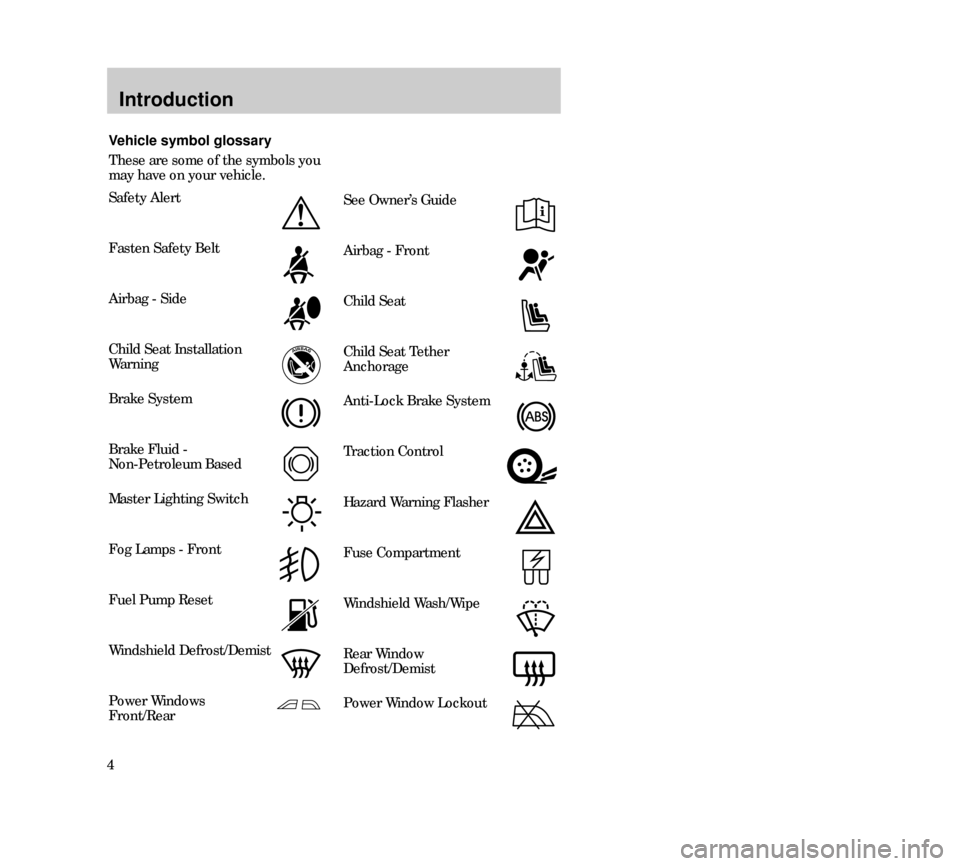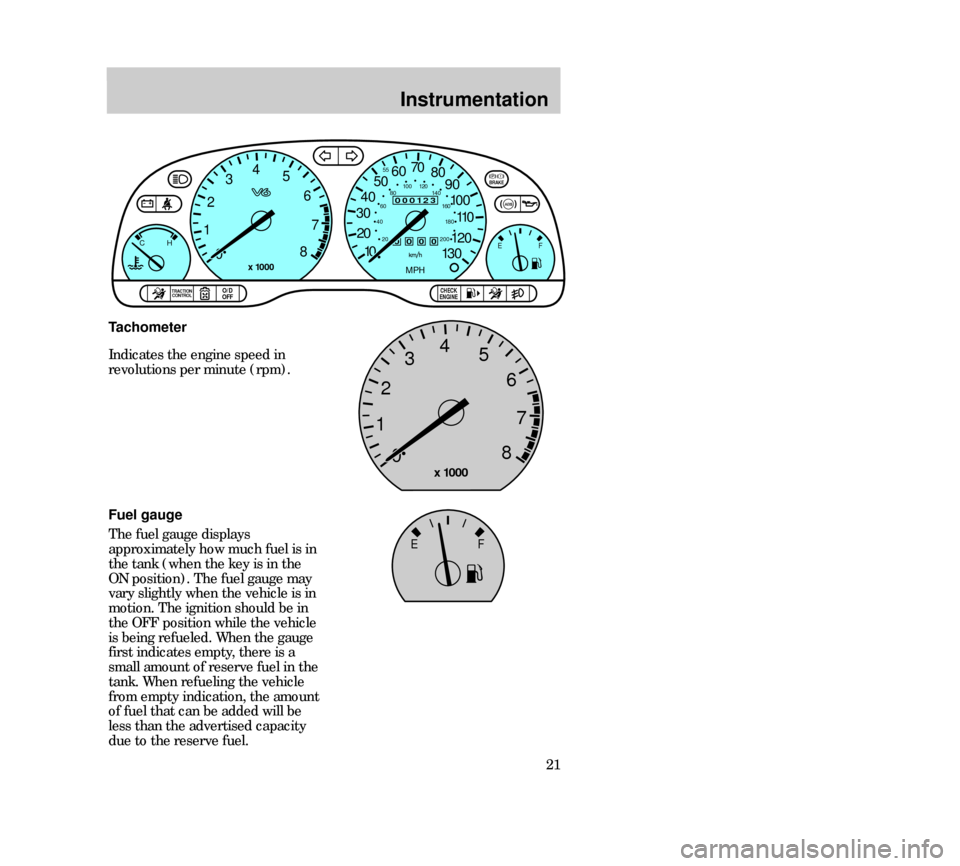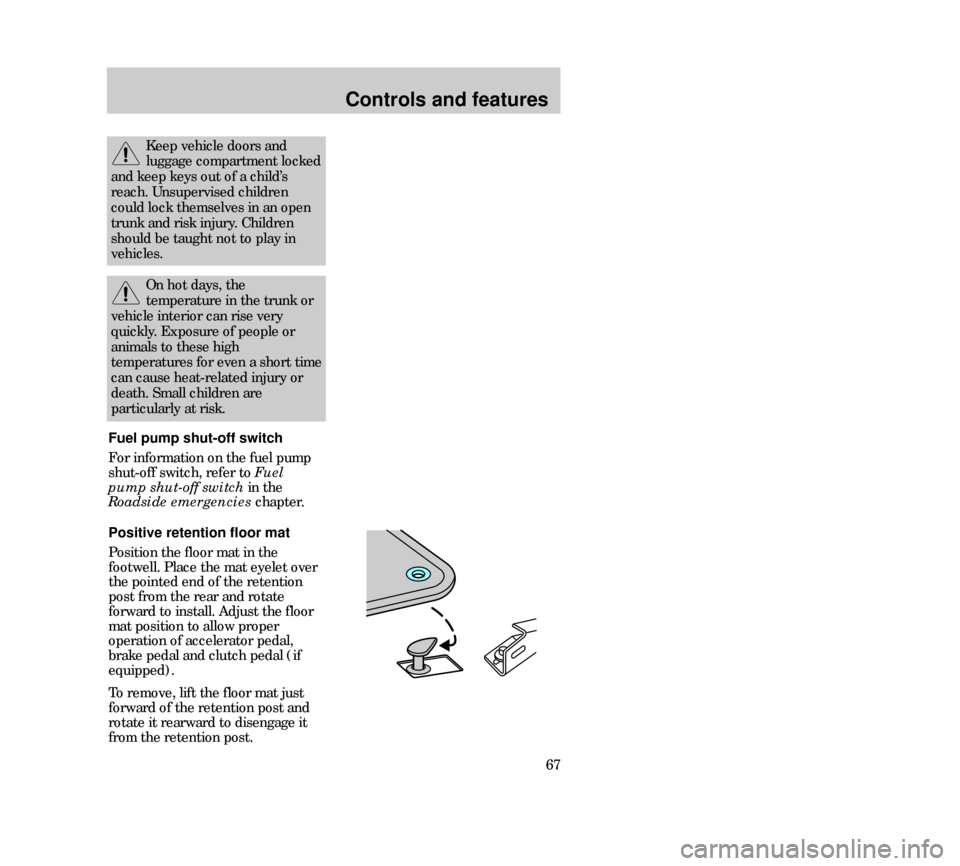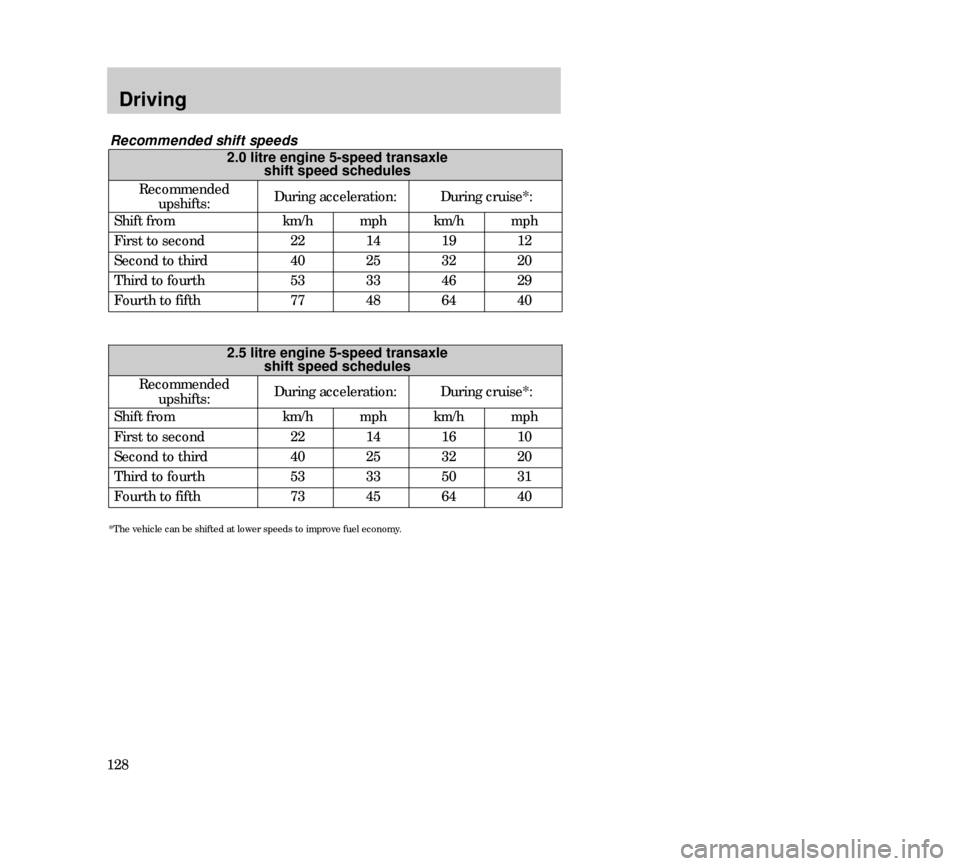fuel Mercury Mystique 2000 Owner's Manuals
[x] Cancel search | Manufacturer: MERCURY, Model Year: 2000, Model line: Mystique, Model: Mercury Mystique 2000Pages: 248, PDF Size: 2.2 MB
Page 4 of 248

Introduction
4Vehicle symbol glossary
These are some of the symbols you
may have on your vehicle.
Safety Alert
Fasten Safety Belt
Airbag - Side
Child Seat Installation
Warning
Brake System
Brake Fluid -
Non-Petroleum Based
Master Lighting Switch
Fog Lamps - Front
Fuel Pump Reset
Windshield Defrost/Demist
Power Windows
Front/Rear
See Owner’s Guide
Airbag - Front
Child Seat
Child Seat Tether
Anchorage
Anti-Lock Brake System
Traction Control
Hazard Warning Flasher
Fuse Compartment
Windshield Wash/Wipe
Rear Window
Defrost/Demist
Power Window Lockout
11MIten 24.6.99 15:01 Uhr Seite 4
Page 13 of 248

Instrumentation
13 What you should do if the check
engine light illuminates
Light turns on solid:
This means that the OBD II system
has detected a malfunction.
Temporary malfunctions may cause
your check engine light to
illuminate. Examples are:
• The vehicle has run out of fuel
(The engine may misfire or run
poorly.)
• Poor fuel quality or water in the
fuel
• The fuel cap may not have been
securely tightened. The check engine indicator light
illuminates when the ignition is
first turned to the ON position to
check the bulb. If it comes on
after the engine is started, one of
the engine’s emission control
systems may be malfunctioning.
The light may illuminate without a
driveability concern being noted.
The vehicle will usually be drivable
and will not require towing.
12MInen 24.6.99 15:03 Uhr Seite 13
Page 14 of 248

Instrumentation
14These temporary malfunctions can
be corrected by filling the fuel tank
with good quality fuel and/or
properly tightening the fuel cap.
After three drive cycles without
these or any other temporary
malfunctions present, the check
engine light should turn off. (A
driving cycle consists of a cold
engine startup followed by mixed
city/highway driving.) No
additional vehicle service is
required.
If the check enginelight remains
on, have your vehicle serviced at
the first available opportunity.
Light is blinking:
Engine misfire is occuring which
could damage your catalytic
converter. You should drive in a
moderate fashion (avoid heavy
acceleration and deceleration) and
have your vehicle serviced at the
first available opportunity.
Under engine misfire
conditions, excessive
exhaust temperatures could
damage the catalytic converter,
the fuel system, interior floor
coverings or other vehicle com-
ponents, possibly causing a fire.
12MInen 24.6.99 15:03 Uhr Seite 14
Page 15 of 248

Instrumentation
15
CHECK
ENGINE
CHECK
ENGINE
Low fuel reminder
Illuminates as an early reminder of
a low fuel condition indicated on
the fuel gauge (refer to Fuel
Gauge in this chapter for more
information). When refueling the
vehicle after the light first comes
on, the amount of fuel that can be
added will be less than the
advertised capacity since there is
still fuel in the tank. The ignition
must be in the ON position for this
lamp to illuminate. The lamp will
also illuminate for several seconds
immediately after the ignition is
turned to the ON position
regardless of the fuel level for bulb
verification.CHECK
ENGINE
Air bag readiness
Briefly illuminates when the
ignition is turned on. If the light
fails to illuminate, continues to
flash, or remains on, have the
system serviced immediately.
Front foglamps (if equipped)
Illuminates when foglamps are
switched on.
Refer to Foglamp controlin the
Controls and features chapter for
notes on use.
12MInen 24.6.99 15:03 Uhr Seite 15
Page 19 of 248

Instrumentation
19 Headlamps on warning chime
Sounds when the headlamps are
on, the ignition is off (and the key
is not in the ignition) and the
driver’s door is open.
Key-in-ignition warning chime
Sounds when the key is left in the
off/lock or accessory position and
the driver’s door is open.
Safety belt warning chime
For information on the safety belt
warning chime, refer to the
Seating and safety restraints
chapter.
Testing the warning and
indicator lights and chimes
Turn the ignition key to the on
position without starting the
engine. The following warning and
indicator lights will illuminate
briefly: charging system, safety belt
(does not illuminate, if the driver’s
safety belt is fastened), traction
control, ABS, brake, low coolant,
low fuel, engine oil pressure, check
engine and air bag readiness.
If any of these lights do not
illuminate, see your dealer or
qualified service technician.
12MInen 24.6.99 15:03 Uhr Seite 19
Page 21 of 248

Instrumentation
21
EF
Fuel gauge
The fuel gauge displays
approximately how much fuel is in
the tank (when the key is in the
ON position). The fuel gauge may
vary slightly when the vehicle is in
motion. The ignition should be in
the OFF position while the vehicle
is being refueled. When the gauge
first indicates empty, there is a
small amount of reserve fuel in the
tank. When refueling the vehicle
from empty indication, the amount
of fuel that can be added will be
less than the advertised capacity
due to the reserve fuel.
000123
000010 20 3040506070
80
90
110
120
13 0
MPH
20 4060
55
80120 10 0
14 0
160
18 0
20010 0
EF12
03
x 1000
4
5
6
7
8
O/D
OFFCHECK
ENGINE
BRAKE
TRACTION
CONTROL
CH
Tachometer
Indicates the engine speed in
revolutions per minute (rpm).
12
03
x 1000
4
5
6
7
8
12MInen 24.6.99 15:03 Uhr Seite 21
Page 67 of 248

Controls and features
67 Fuel pump shut-off switch
For information on the fuel pump
shut-off switch, refer to Fuel
pump shut-off switch in the
Roadside emergencies chapter.
Positive retention floor mat
Position the floor mat in the
footwell. Place the mat eyelet over
the pointed end of the retention
post from the rear and rotate
forward to install. Adjust the floor
mat position to allow proper
operation of accelerator pedal,
brake pedal and clutch pedal (if
equipped).
To remove, lift the floor mat just
forward of the retention post and
rotate it rearward to disengage it
from the retention post.
Keep vehicle doors and
luggage compartment locked
and keep keys out of a child’s
reach. Unsupervised children
could lock themselves in an open
trunk and risk injury. Children
should be taught not to play in
vehicles.
On hot days, the
temperature in the trunk or
vehicle interior can rise very
quickly. Exposure of people or
animals to these high
temperatures for even a short time
can cause heat-related injury or
death. Small children are
particularly at risk.
13MCfen 24.6.99 15:07 Uhr Seite 67
Page 124 of 248

Driving
124•D (Overdrive)
Note that the vehicle’s gearshift is
console-mounted on the floor. The
transaxle control switch (TCS) is
located on the gearshift handle.
The transaxle control indicator
light (O/D light) is located on the
instrument panel.
Overdrive is not shown on the
display, but is the default mode for
the D gearshift position. This is the
normal driving mode for the best
fuel economy. The transaxle
operates in gears one through four.
The O/D light is off (not
illuminated) during normal vehicle
operation.
Overdrive can be deactivated by
pressing the transaxle control
switch (TCS) located on the
gearshift handle. The O/D OFF
indicator light will illuminate in the
instrument cluster. •N (Neutral)
The wheels of the transaxle are not
locked. Your vehicle will roll freely,
even on the slightest incline, unless
the parking brake or brakes are on.
22MDren 24.6.99 15:26 Uhr Seite 124
Page 128 of 248

Driving
128
*The vehicle can be shifted at lower speeds to improve fuel economy.
22 Recommended shift speeds
2.0 litre engine 5-speed transaxle
shift speed schedules
Recommended
upshifts:
Shift from km/h mph
14
25
33
48
40
53
77mph
12
20
29
40
km/h
19
32
64 First to second
Second to third
Third to fourth
Fourth to fifth
During acceleration:During cruise*:
46
2.5 litre engine 5-speed transaxle
shift speed schedules
km/h
mphkm/hmph
10
20
31
40
16
32
50
64
14
25
33
45
22
40
53
73
Shift from
First to second
Second to third
Third to fourth
Fourth to fifthRecommended
upshifts:During acceleration:
During cruise*:
22MDren 24.6.99 15:26 Uhr Seite 128
Page 140 of 248

Driving
140FUEL CONSUMPTION
Fuel economy can be improved by
avoiding:
• lack of regular, scheduled
maintenance,
• excessive speed,
• rapid acceleration,
• driving with the brake pedal
depressed,
• sudden stops,
• extended engine idling,
• use of speed control in hilly
terrain,
• extended use of the air
conditioner, defroster, rear window
defroster and other accessories,
• underinflated tires,
• heavy loads,
• aftermarket add-ons such as
bike, ski or luggage racks, bug
deflectors, etc.
23MREen 24.6.99 15:28 Uhr Seite 140